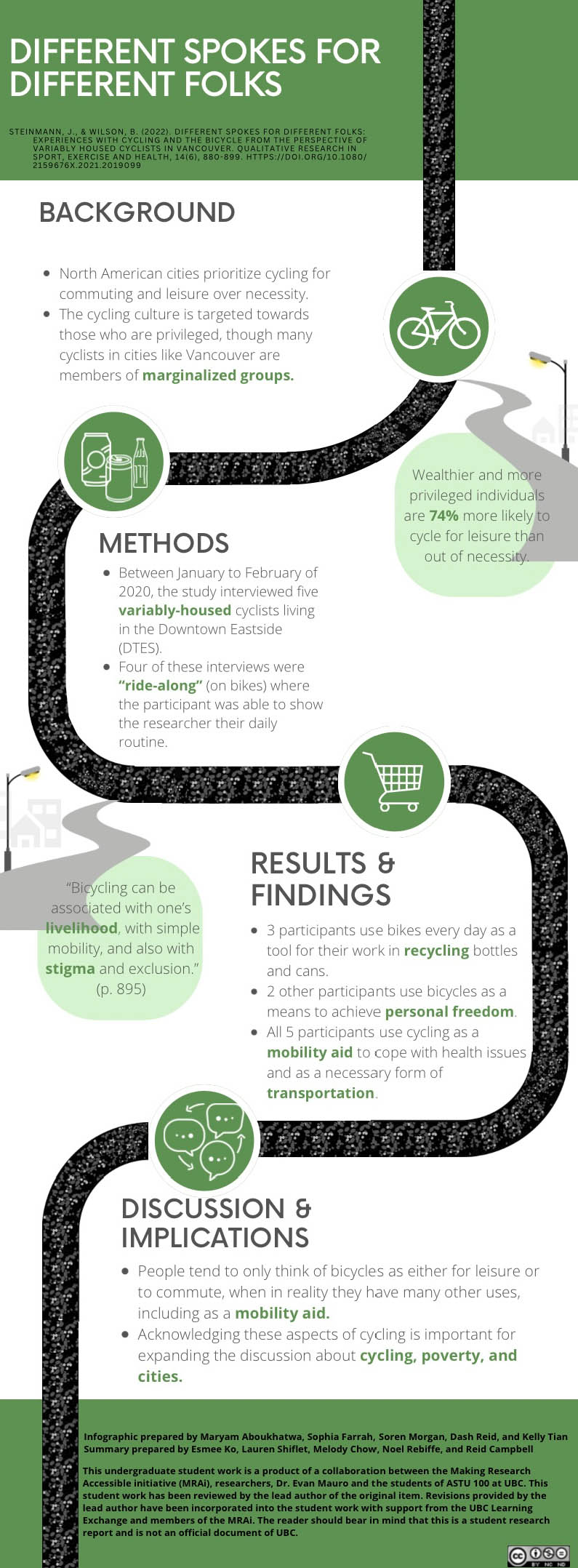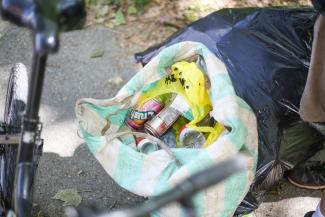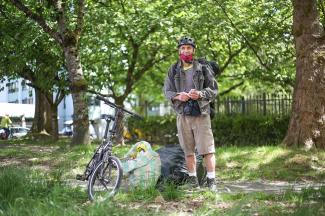This digital museum explores the work of Jeanette Steinmann (with contributions from Brian Wilson) on bicycling and homelessness. Cycling is often celebrated as a sustainable alternative to driving, but many people living in Vancouver's Downtown Eastside neighbourhood cycle out of necessity. Jeanette's original MA research offers a glimpse into the ways that five variably-housed men use bicycles to get around and to support informal recycling work. Scroll through the following digital museum to learn more about this work.
Summary of bicycling and homelessness study
Bicycling, the fastest growing mode of transportation in Vancouver, has become popularized due to its associations with positive health, economic, and environmental outcomes. Cycling has been taken up by upwardly-mobile and often white city-dwellers as a lifestyle choice signifying environmentally-conscious and responsible citizenship (Golub et al., 2016). At the same time, many people who experience homelessness or are unstably-housed may depend on walking and cycling for transportation, and may cycle out of necessity, not by choice (Lugo, 2018). Little research has focused on the experiences of low-income people who cycle out of necessity. Relatedly, more research is needed regarding how cycling is connected to larger issues of inequality, such as Vancouver’s current housing crisis, opioid epidemic, and settler-colonial history. The study was guided by critical and interpretive theoretical perspectives that helped bring attention to social inequities and the experiences and perspectives of marginalized individuals. Using primarily ride-along interviews, Jeanette conducted five in-depth semi-structured interviews with homeless or unstably-housed men who ride bicycles.
Results indicate that bicycles were used for a variety of reasons, including for leisure, for transport, and for informal recycling work. The bicycle was a mobility aid for participants who had multiple health issues. Participants met their bike-related needs through an underground economy and a network of places and people. They cultivated relationships along these networks that helped them ‘get by’ despite experiencing significant stigma from the public and from police, as well as structural barriers. These results suggest that homeless and unstably-housed men who use bicycles employ varied and creative means to get by, and that work remains to decriminalize informal recycling and de-stigmatize low-income cyclists in Vancouver. See below for a quote from George, a participant, on the usefulness of biking compared to walking:
Because I got tendinitis of the left foot, I can ride my bike a hundred miles a day, but I can only walk a couple blocks before I start crippling up, and once ya start limping… ya compensate, before you know it you’re a pretzel, you know your back’s out of place... - George, cycling recycler
Jeanette's project on homelessness and bicycling is part of the Downtown Eastside Research Access Portal, led by the Making Research Accessible initiative (MRAi), a partnership at the University of British Columbia (UBC) between the Learning Exchange and the Library. As part of this initiative, ASTU 100 students turned the article "Different spokes for different folks: experiences with cycling and the bicycle from the perspective of variably-housed cyclists in Vancouver" into an accessible infographic -- see below.

Mobility Justice Explainer Video
In the following video, Jeanette discusses the concept of mobility justice, using this research project as an example.
Academic Articles
News Articles
References
Golub, A., Hoffmann, M. L., Lugo, A. E., & Sandoval, G. F. (Eds.). (2016). Bicycle justice and urban transformation: Biking for all?. New York: Routledge.
Lugo, A. (2018). Bicycle/race. Transportation, culture, and resistance. Portland, OR: Microcosm Publishing.
Digital Museum Credits
Contributors: Jeanette Steinmann, UBC; Dr. Brian Wilson, UBC
Corresponding author: Jeanette Steinmann, UBC, jeanette.steinmann@ubc.ca

